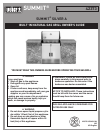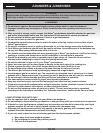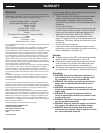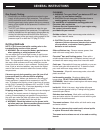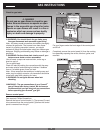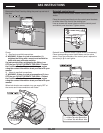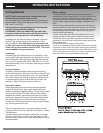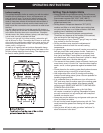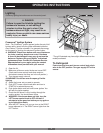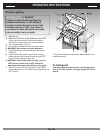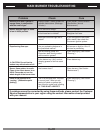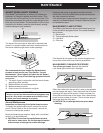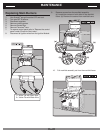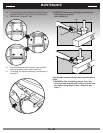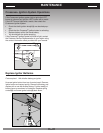Special offers from our partners!

Find Replacement BBQ Parts for 20,308 Models. Repair your BBQ today.

Buy Weber Grill Parts. It couldn't be easier. Find your Weber parts here.

4
GENERAL INSTRUCTIONS
CLEANING
ƽ WARNING: Turn your Weber
®
gas barbecue OFF and
wait for it to cool before cleaning.
ƽ CAUTION: Do not clean your Flavorizer
®
bars or
cooking grates in a self-cleaning oven.
For availability of replacement cooking grates and
Flavorizer
®
bars contact the
Customer Service Representative in your region using
the contact information sheet
provided with your manual.
Outside surfaces - Use a warm soapy water solution to
clean, then rinse with water.
ƽ CAUTION: Do not use oven cleaner, abrasive
cleansers (kitchen cleansers) cleaners that contain
citrus products, or abrasive cleaning pads on
barbecue or cart surfaces.
Slide out Bottom tray - Remove excess grease, then
wash with warm soapy water, then rinse
Flavorizer
®
bars and Cooking grates - Clean with a
suitable brass bristle brush. As needed, remove from grill
and wash with warm soapy water, then rinse with water.
Catch pan - Disposable foil trays are available, or you can
line the catch pan with aluminum foil. To clean the catch
pan, wash with warm soapy water, then rinse.
Thermometer - Wipe with warm soapy water; clean with
plastic scrub ball.
Inside cooking module - Brush any debris off of
burner tubes. DO NOT ENLARGE BURNER PORTS
(OPENINGS). Wash inside of cooking box with warm soapy
water and a water rinse.
Inside Lid - While lid is warm, wipe inside with paper
towel to prevent grease build-up. Flaking built-up grease
resembles paint fl akes.
Stainless steel surfaces - Wash with a soft cloth and a
soap and water solution. Be careful to scrub with the grain
direction of the stainless steel.
Thermoset surfaces - Wash with a soft cloth and a soap
and water solution.
Do not use cleaners that contain acid, mineral spirits
or xylene. Rinse well after cleaning.
Thermoset work surfaces are not to be used as cutting
boards.
Grilling Methods
NOTE: If grill looses heat while cooking refer to the
troubleshooting section of this manual.
ƽ WARNING: Do not move the Weber
®
gas barbecue
when operating or while barbecue is hot.
You can adjust the Left and Right burners in each burner
set as desired. The control settings are High (H), Medium
(M), Low (L), or Off (O).
Note: The temperature inside your cooking box for the fi rst
few uses, while surfaces are still very refl ective, may be
hotter than those shown in your cookbook. Cooking condi-
tions. Such as wind and weather, may require the adjust-
ment of the burner controls to obtain the correct cooking
temperatures.
If burners go out during cooking, open lid, turn off all
burners and wait fi ve minutes before relighting.
Preheating - Your Weber
®
gas barbecue is an energy-ef-
fi cient appliance. It operates at an economical low BTU
rate. To preheat: after lighting, close lid and turn all burners
to high (HH). Preheating to between 500° and 550° F (260°
and 290° C) will take 10 to 15 minutes depending on condi-
tions such as air temperature and wind.
Drippings and grease - The Flavorizer
®
bars are designed
to "smoke" the correct amount of drippings for fl avorful
cooking. Excess drippings and grease will accumulate in
the catch pan under the slide out bottom tray. Disposable
foil drip pans are available that fi t the catch pan.
ƽ WARNING: Check the bottom tray for grease build-
up before each use. Remove excess grease to avoid
a grease fi re in the slide out bottom tray.
Gas Supply Testing
• Disconnect your Weber
®
gas barbecue when the gas
supply is being tested at high pressures. This appliance
and its individual shutoff valve must be disconnected
from the gas supply piping system during any pressure
testing of that system at test pressures in excess of 1/2
psig (3.5 kPa).
• Turn OFF your Weber
®
gas barbecue when the gas
supply is being tested at low pressures. This appliance
must be isolated from the gas supply piping system by
closing its individual manual shutoff valve during any
pressure testing of the gas supply piping system at the
pressure equal to or less than 1/2 psig (3.5 kPa).



